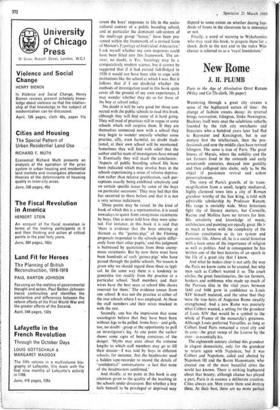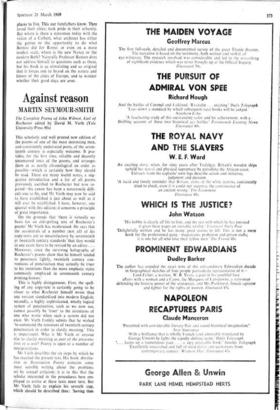Paris in the Age of Absolutism Orest Ranum (Wiley and
Co 75s cloth, 38s paper)
New Rome
J. H. PLUMB
Wandering through a great city creates a sense of the haphazard nature of time : the change of fashion creates decay; its reversal brings renovation; Islington, Stoke Newington, Hackney itself were once the salubrious suburbs founded by the rich city merchants and financiers who- a hundred years later had fled to Bayswater and Kensington, but in our century first the intellectuals, then the pro- fessionals and now the middle class have revived Islington. The same is true of Paris. The great houses of Marais, where the nobility and the tax farmers lived in the sixteenth and early seventeenth centuries, decayed into gentility and then collapsed into slums, only to be the object of passionate revival and ardent preservationism.
The story of Paris's growth, of its trans- mogrification from a small, -largely mediaeval, highly clustered town into a city of Roman grandeur worthy of the Sun King, is told with admirable scholarship by Professor Ranum. His range is enviably wide. Most historiani fight shy of literary matters, but Corneille, Racine and Moliere have no terrors for him'. His sensitivity and knowledge of music, architecture and painting are equally great. He is as much at home with the complexity of the Parisian constitution as its tax system and economic life. Above all, he is a social historian with a keen sense of the importance of religion as well as politics. And in consequence he has written one of the best histories of an epoch in the life of a great city that I know.
And what he makes clear is not only the way the Paris we know came to be created, but why men such as Colbert wanted it so. The court circles, the great functionaries, the tax farmers, bankers and noblemen who made up much of the Parisian elite in the vital years between 1660 and 1680 grew in confidence as Louis XIV himself matured, and the sense that they 'were the true heirs of Augustan Rome steadily strengthened. And a new Rome was precisely what Colbert wanted, a setting for the grandeur of Louis XIV that would be a symbol to the whole of France of the monarchy's greatness. Although Louis preferred Versailles, as long as Colbert lived Paris remained a royal city and its core—the great sweep of the Louvre by the river—is essentially his.
The eighteenth century clothed this grandeur in elegant domesticity, only for the grandeur to return again with Napoleon, but it was Colbert and Napoleon, aided and abetted by Napoleon Ill and the Baron Haussmann, who created one of the most beautiful cities the world has known. There is nothing haphazard about that beauty; although chance has played a part, Paris is in essence a deliberate creation. Cities always are. Men create them and destroy them. At their best, there are no more perfect
places to live. This our forefathers knew. They loved their cities; took pride in their urbanity. But where is there a statesman today with the vision of a Colbert, what architect has either the genius or the opportunity to do what Bernini did for Rome; or even on a more modest scale, where is the new Nancy or the modern Bath? Naturally Professor Ranum does not address himself to questions such as these, but his book is so stimulating and so original that it forces one to brood on the nature and future of the cities of Europe, and to wonder whether their good days are over.











































 Previous page
Previous page